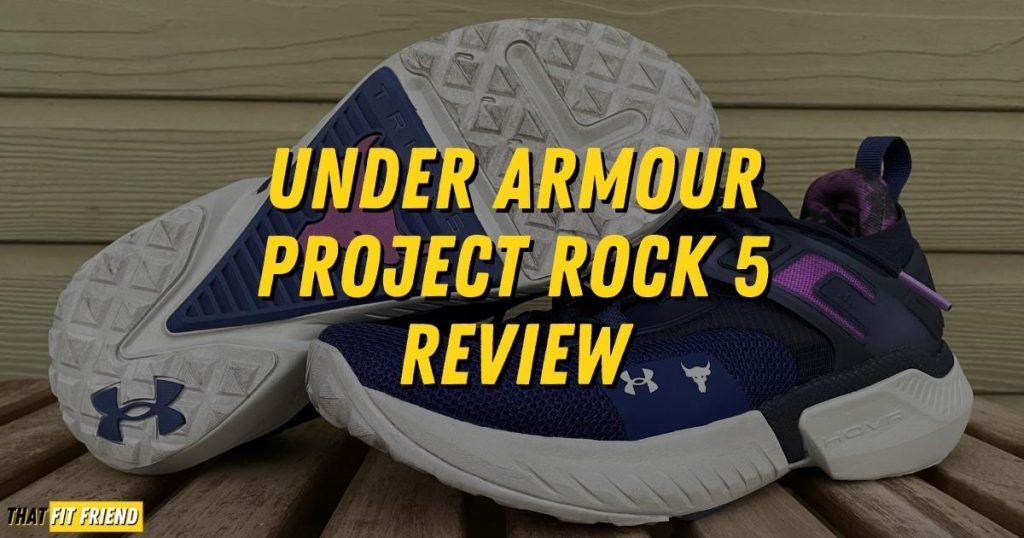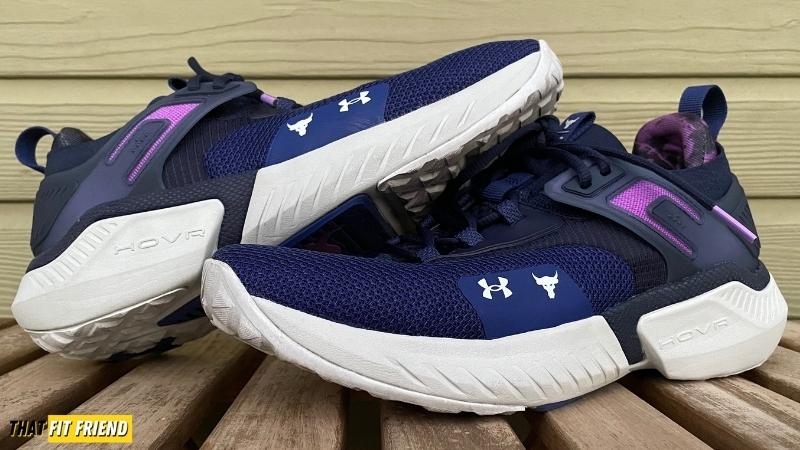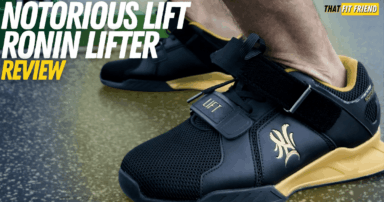That Fit Friend is supported by its readers. I [Jake] run this site myself and buy the gear reviewed. If you purchase through my site, I may earn commissions on sales. Read more here!
The Under Armour Project Rock 5 is the latest training shoe to debut in the popular Project Rock training shoe line. This model features a few notable upgrades from the previous UA Project Rock 4.
I thought the UA Project Rock 4 was a pretty good training shoe, but there were certainly areas where it could be improved. When the UA Project Rock 5 was released, I was super excited to put this shoe to the test to see how UA improved this shoe.
Across the board, the UA Project Rock 5 has delivered a strong performance in the gym. However, there are a few areas that could still use improvement with these shoes, though, more on that below.
Who Should Invest In the UA Project Rock 5?
The Under Armour Project Rock 5 is one of the better, if not best Project Rock training shoes to date. As someone who enjoyed the UA Project Rock 2, the Project Rock 5 is rivaling that model and is quickly becoming one of my favorite iterations.
I think if you’ve worn other UA Project Rock shoes and feel similar to the above with your favorite iterations, then you’ll enjoy the performance of the UA Project Rock 5. This shoe’s performance has been leveled up across the board.
The midsole is stable enough for heavier recreational lifting and the HOVR midsole gives you a nice level of responsiveness for versatile training. It’s a good general training shoe, and if you like The Rock, then you should resonate with this model.
That being said, I don’t think the UA Project Rock 5 will be the best for lifters who are very specific with their barbell training or for CrossFit-focused individuals, but for Project Rock fans and those who are more general with their training, the Project Rock 5 is solid.
UA Project Rock 5 Pros
Over the course of my training and testing of the UA Project Rock 5, I found multiple pros and aspects to like with this shoe.
- Strong Performance for General Training
- Reworked Heel Strap and Upper Feel Durable
- Better Sole Construction for Versatile Training
The first aspect to like about the Under Armour Project Rock 5 is that it’s a pretty well-rounded training shoe. For lifting, versatile training, and athletic-style training, I thought the UA Project Rock 5 did a pretty good job.
This shoe was stable enough to support my deadlifts up to 495 lbs and I liked the responsiveness of the midsole for plyometrics and multi-directional exercises. I think if you like to lift, jump, and do short runs every week, you’ll like the UA Project Rock 5.
I also like the TriBase tech on this shoe’s outsole and the tread patterning on the forefoot, midfoot, and heel. I don’t think you’ll have slip issues in the gym on rubber gym floors, wooden platforms, or turf in this model, no matter what movement you’re doing.
In addition, once I tightened the laces in this model based on my training needed (more on this below in my cons), I thought the upper did a good job at promoting full foot security. I never had spillover issues when doing things like broad jumps and lateral jumps, or other HIIT-style training.
The second aspect to like about the UA Project Rock 5 is that it appears Under Armour fixed some of the durability issues that existed in the UA Project Rock 4. More specifically, there are three construction areas that I feel are improved in this model.
For starters, Under Armour removed the midfoot TPU eyelet in the PR5, which is great because that construction component could cause some lace breakdown over time. Additionally, they reworked the TPU heel clip.
In the UA Project Rock 5, the TPU in the heel now wraps up to the midfoot and serves as the top two eyelets. In my opinion, this is a positive change because the previous TPU layer in the PR4 could cause some breakdown around the boot due to friction.
The upper construction in this model also feels like it’s of a higher quality. The mesh around the forefoot also feels a bit more durable and abrasion-resistant, and the synthetic overlays around the midfoot and boot feel pretty well put together.
The last feature to like about Project Rock 5 is that the sole construction feels a little better from a performance point of view compared to prior iterations. There’s no denying that the Project Rock shoes come with some thick and clunky soles.
This isn’t necessarily a bad thing, but you can lose out on articulation and flexibility with thicker-soled training shoes. In the UA Project Rock 5, Under Armour reworked the midfoot construction and there’s now a cut that gives the PR5 a little more midfoot mobility.
It’s a small and subtle difference, but I found it to boost this shoe’s performance, especially when it came to things like walking lunges, cleans, and other movements where I needed greater levels of toe box mobility.
UA Project Rock 5 Cons
Despite enjoying the Under Armour Project Rock 5’s performance and thinking it’s a level up over the PR4, there are a few cons to note about this shoe.
- Not Great for Minimalist Training Shoe Lovers
- Upper Security Can Feel Awkward At Times
- Falls Short for Custom Insoles and Laces Run Long
The first drawback to the Under Armour Project Rock 5 is that it’s not going to be the best shoe for those that love more minimalist-feeling training shoes. If you enjoy more articulation and less stack height in your trainers, then the PR5 won’t be a good pick for you.
I mentioned above that the UA Project Rock 5 has more articulation than prior Project Rock models, but that’s relatively speaking. This shoe’s thicker sole construction still gives them a thicker and clunkier feel compared to other training shoes.
If you’re used to Under Armour Project Rock training shoes, then this drawback likely won’t come as or be a surprise for you. However, if you do want a UA training shoe with a lower stack height and more mobility, then you could explore a model like the UA TriBase Reign 6.
Another potential drawback that could bother some with the UA Project Rock 5 is that the upper security could be a little better. At times, I found myself sliding forward into the toe box of this shoe so I had to then focus on really tightening these shoes for training.
This helped with the upper security, however, the tightened laces then caused an overlap of the upper material and the base of the midfoot. I didn’t feel as though this impacted performance, but I could see this bothering those with narrow feet or lower arches.
On top of the upper security, I also think you can feel “forward” at times in this shoe. This model’s blockier heel with its toe spring made it a little tough to sink into the hips during exercises like kettlebell swings.
This isn’t the biggest deal as most will adjust to this shoe’s sole construction, but it’s something to keep an eye on as you acclimate to this shoe. The heel and toe spring in this model could create some challenges for certain exercises.
The last two drawbacks that come with the UA Project Rock 5 are that this model will not be the best pick for those who use custom insoles and orthotics, and the laces run pretty long.
This shoe does not feature a removable insole and the upper volume in the forefoot runs fairly low. This could be problematic for those that use thicker inserts for training, and you may want to explore different options.
Additionally, the laces in this model could be shortened a bit, as they’re pretty long even when double-knotting them. The laces and their length don’t really impact performance, but they can be pretty annoying to deal with.
UA Project Rock 5 Performance
To discuss the performance of the UA Project Rock 5, I’m going to break down how this performs in a variety of contexts. I’ll cover how this performs for lifting, versatile training, short runs, and daily wear.
This way, if you’re considering the UA Project Rock 5, an older iteration, or a different training shoe, you can cross-reference this shoe’s performance to your training needs.
Testing the UA Project Rock for Lifting
For lifting, I thought the UA Project Rock 5 did a pretty good job. Stability-wise, this shoe should be stable enough for most recreational lifters who plan to use this shoe for machines, general barbell work, and accessory exercises.
Once again, the UA Project Rock 5 did an okay job when working up to 495 lbs in deadlifts. The stack height in this shoe isn’t the best for serious deadlift training, but for weights around or under that threshold, midsole compression shouldn’t hinder your performance.
I also enjoyed how this model felt for cleans and hang cleans, I felt as though the toe box was a little more lively in this shoe compared to prior Project Rock iterations. The sole feels a little better for more dynamic exercises which I’m a fan of.
I think if you want a shoe for general strength work every week, then you’ll enjoy the UA Project Rock 5. This model works for various exercises and it’s stable enough for most lifters, in my opinion.
Testing the UA Project Rock for Versatile Training
For versatile training, including plyometrics, athletic-style workouts, and HIIT, I enjoyed the UA Project Rock 5’s performance for the most part. More specifically, I have three things that I like about this shoe for this context and one complaint.
The first thing to like is the responsiveness of this shoe’s midsole. I like the “springy” feel that you get from the HOVR midsole in this model and enjoyed its performance for box jumps, pogos, jump rope, and lateral work like skater strides.
Another aspect to like is the TriBase tech on the outsole and reworked sole construction. In the UA Project Rock 5, I feel like you get a little more of an athletic-fitting and performing shoe compared to previous iterations that can feel blocky in these settings.
When cutting and doing sharp turns, the UA Project Rock 5 hung with me and the outsole gripped well to let me propel in whatever direction I was heading in. Speaking of cutting, the upper also did a pretty good job with security.
While I’m not super stoked about this shoe’s upper when wearing them looser and that’s my complaint in this training context, once you tighten them accordingly, the security in this shoe is pretty solid. I don’t think most will have an issue spilling over the sole of this shoe.
Testing the UA Project Rock for Short Runs and Daily Wear
For short runs, the UA Project Rock 5 is okay for runs ranging from 1-3 miles tops. If you want these for short warm-up or cooldown runs, then they should be fine for tackling that job. I wouldn’t run longer than 3-miles in this shoe and even that’s pushing it.
In the context of sprints, I thought this shoe did an okay job. It’s not my favorite training shoe for sprinting as I’d rather go with an APL TechLoom Tracer or PUMA Fuse 2, but for general sprint work, the UA Project Rock 5 did an okay job.
The UA Project Rock is just okay for daily wear. It is not my favorite training shoe for long walks, and I’d pass on it as a travel-friendly training shoe. This model can feel pretty clunky and heavy at times.
In addition, I’m not super fond of the upper security in this shoe when wearing them looser, and if you don’t feel like cranking your laces tight for casual use like me, then you’ll likely not enjoy the PR5 for daily wear as well.
UA Project Rock 5 Sizing
For the Under Armour Project Rock 5, I think most lifters and athletes should be safe going true to size in this model. The length fits true in this shoe and they have neutral width or “normal” as described on Under Armour’s site.
The Project Rock 5’s fit is relatively consistent with the Project Rock 4, so if you’ve ever worn that model, I’d suggest sizing this shoe the same. Additionally, they’re also similar in length and width to the UA TriBase Reign 4 if you’re familiar with that model.
My only sizing concern with the Project Rock 5 involves the toe box’s fit for narrow feet. You somewhat have to crank this shoe’s laces tight to get a secure fit, otherwise, I found myself sliding around in the forefoot when doing explosive exercises.
If you have a narrow foot, then you may want to consider this before investing. When you tighten the forefoot a lot, you do get a little overlap of material which also isn’t the best from an aesthetic point of view. Also, very wide feet may find a little limited in his shoe’s toe box.
- UA Project Rock 5 Sizing Thoughts: Go true to size.
If you have additional sizing and fit questions about the UA Project Rock 5, drop a comment below or reach out to me personally.
UA Project Rock 5 Vs UA Project Rock 4
While some similarities exist between the UA Project Rock 4 versus the UA Project Rock 5, multiple construction differences make one of these models better than the other, in my opinion.
I touched on some of these differences above, but I wanted to highlight them in their own respective section in case you’re considering the question of Project Rock 5 versus Project Rock 4. I’ll cover three major differences to note between these shoes.
The first difference is the reworked TPU in the heel on each model. In the UA Project Rock 4, the TPU clip could cause long-term durability issues with the boot construction due to the tip of it tearing through the upper around the heel.
The UA Project Rock 5 has a reworked heel-to-midfoot strap that has seemed to fix this issue and I don’t think most lifters and athletes will run into durability issues with this construction change, at least right away. The PR5 also removed the midfoot TPU eyelet.
Another difference to note between the Project Rock 5 and 4 is their upper constructions. The upper in the Project Rock 4 was constructed with a looser mesh and knit around the boot. To be honest, the upper in the PR4 could have used a quality buff.
In the UA Project Rock 5, we now have a reworked mesh in the forefoot that feels more abrasion resistant and it has a “rubbery” finish to it. The midfoot and boot also have overlays that give them a more structured feel.
Another difference between the UA PR4 and PR5 is their sole constructions. The UA Project Rock 5 has a reworked outsole structure and cut at the midfoot that gives it a little more articulation than the UA Project Rock 4. It’s subtle, but it makes a difference.
Performance-wise, both of these are similar when it comes to overall stability and versatility. However, if we get more niche and into the details, I like the UA Project Rock 5 better due to the aforementioned sole change and its buffed upper durability.
Winner: If you’re on the fence between these two shoes and the price doesn’t bother you, go with the UA Project Rock 5. That being said, if you can get a sick deal on the UA Project Rock 4 such as $70+ USD off, then the PR4 should suffice.
Also, if you’ve worn the Project Rock 5 and you love their construction and fit, I’d stick with them over the PR5. I’m not convinced diehard Project Rock 4 lovers will enjoy the PR5’s changes, especially if you loved the bootie construction of that shoe.

UA Project Rock 5

UA Project Rock 4
Price Breakdown
For the UA Project Rock 5, you can expect to pay $150 USD. Compared to prior Under Armour Project Rock shoes, this price has remained consistent and unchanged over the last few iterations.
Honestly, the price point for these shoes is a little hit or miss. I think this model is a step in the right direction compared to the UA Project Rock 4 and it’s a decent training shoe for a little bit of everything.
Plus, if you like The Rock’s branding and products, and resonate with Dwayne Johnson’s message, then this model can also be worth it. Conversely, for $150 USD, there are training shoes that outperform this model for cross-training, lifting, and CrossFit.
If you don’t care about The Rock’s branding and the price point is giving you pause, I’d pass on this shoe and look for a stronger performing shoe that will cost the same, if not a little less.
Construction Details
The Under Armour Project Rock 5 has received a few notable construction updates. Below are the most important construction changes to know about this model.
- Heel-to-Toe Drop: 8mm
- Weight: 14.45 oz (for my size 10 model)
- Removable Insole: No
- HOVR Midsole
- TriBase Outsole Tech
- TPU Heel-to-Midfoot Strap
- Mesh and Knit Upper
- Beveled Heel
- Disassociated Heel and Forefoot
If you have additional construction-related questions about the UA Project Rock 5, drop a comment below.
Takeaway Thoughts
Overall, I’m a fan of the UA Project Rock 5 and I think it’s a step in a good direction for the Under Armour Project Rock shoe line. This shoe feels more durable than the prior iteration and it delivers a nice level of versatility.
If you’re a fan of The Rock and you want a shoe for general lifting and cross-training, then I think you’ll enjoy the performance of the UA Project Rock 5.
There are a few things that could be improved in this model like the Achilles rub and ability to support customer insoles, but for the most part, this shoe does a good job.
If you have additional questions on the UA Project Rock 5, drop a comment below or reach out to me personally via Instagram (@jake_boly or @that_fit_friend).
































Philip
Hey! I’m currently considering purchasing a pair of the PR5s, and this article is very informative. I have some concerns about sizing, though. I currently wear a pair of UA’s Charged Assert 9 in size 11 4E (X-Wide). If I am to buy this shoe, what size should I get? Or should I just forgo this model instead?
I believe I hit you back on Instagram already, but I’d suggest going up a half-size or passing on this model!